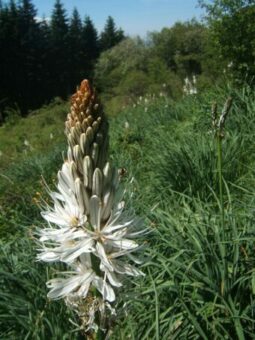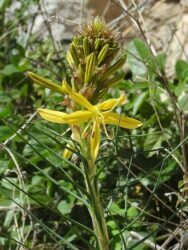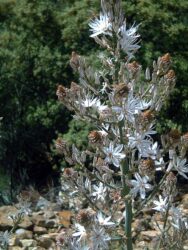In this article, we will discuss how to grow the tall elegant perennial of Asphodelus in containers. It is a tuberous perennial that belongs to its own family of Asphodelaceae- the Asphodel family, where 17 species are known to exist. It used to belong to the lily family but now it is moved to its own family as stated earlier. Asphodelus is native to Europe, especially around the Mediterranean area, Africa, the Middle East and the Indian subcontinent.

They have also been introduced and naturalised in New Zealand, Australia, Mexico and parts of the United States.
In Greek mythology, Asphodelus was associated with death and the underworld. This is probably due to the colour of its leaves and the yellowish flowers that suggest the despair of the underworld and of death itself.
They are noted as a clump-forming rhizomatous, herbaceous perennial with linear, mid-green leaves and in spring, erect leafless stems appear with racemes of white flowers with prominent white or brown bracts.
The flowers appear high above the leaves giving a regal appearance when grown in a large group. Find out how to grow this bulbous perennial of asphodel in containers in this article.
GROWING ASPHODELUS IN CONTAINERS
You have a choice as to how you grow Asphodelus, either from seed or shop-bought, garden-ready species.
GROWING FROM SEED
Asphodelus are easy to grow from seed. All you need to do is start your seeds in early February by filling a tray full of moist seed sowing compost. On top of this, sprinkle thinly the seed and cover them with a very fine layer of sieved seed sowing compost. They will germinate without any additional heat (important as heat can inhibit germination). Place a propagation lid and place it in a cool room.
Be patient and they will germinate in one to 3 months. Once they are large enough to handle, you can prick them out to transplant them into 7.5cm individual pots full of multipurpose compost. Allow them to grow on and in Mid-May, you can start to harden them out for planting in late May outside once all the frosts have passed.
At this stage, you can treat the home-reared seedlings and garden-ready plants in exactly the same way.
First, choose your container making sure it is large enough and looks elegant and has plenty of drainage holes at the bottom.

To the bottom of the container add a 1cm layer of gravel to aid drainage. On top of this create a free-draining growing media by mixing 80% by volume of multipurpose compost with 20% by volume of horticultural grit. Add this until 5cm below the top rim of the container. Dig a hole at the centre of the container slightly bigger than the root ball it came in the original container. Place the plant in so that the top of the root ball is at the same level as the top surface of the compost. Backfill with the growing media so that no gaps remain, using more compost if necessary. Firm the plant in and water well.
BEST GROWING CONDITIONS
Place the container in an area where it will get full sun. You will need to water regularly until the plant is established and then when 5cm below the top surface of the compost feels dry to the touch. The plant would need to be fertilized every spring with a slow-release fertilizer to help give a boost through the growing season. You may find it beneficial if you add a high-potash liquid-fertilizer before the flower spikes are produced to give a better show. You can cut down the spent blooms in early spring as the attractive seed heads will make a talking point over summer, autumn and winter.
PESTS AND DISEASES
In terms of diseases, the plant is relatively trouble-free but in terms of pests, they can suffer from aphids. The best way to deal with them is to try to blast them with a jet of water. If this does not work, you can use a systemic insecticide to deal with the problem. Make sure you follow what is written on the back of the spray bottle.
VARIETIES TO GROW

You are likely to find 4 species that are grown in the UK. The most popular are:
A. albus (White Asphodel) produces tall spikes of white, starry flowers.
Others include A. lutea (now known as Asphodeline lutea – the yellow Aspodel) which produces 1.2m tall, dense spikes of bright, yellow, starry flowers.
A smaller plant is A. liburnica which also produces yellow flowers but the plant is smaller and so are the spikes. The flowers are also produced later in July.
Another midsummer flowering species is A. ramosus which produces white flowers and is much taller than the other, where it can grow up to 1.5m in height. Can be said to be more regal than the others.
CONCLUSIONS
In this article, we have discussed how to grow the bulbous perennial of Asphodelus in containers. They are towering plants with yellow or white flowers and are generally easy to look after. They do not require much but water and food when required and cutting back of dead stems in early spring.
They look great at the back of container displays, where the pastel colours will be appreciated.
If you have any questions or comments that you wish to make on growing Asphodelus in containers, please do so in the comment box below.
Happy Asphodelus growing.
